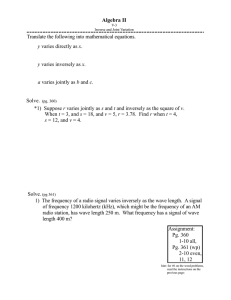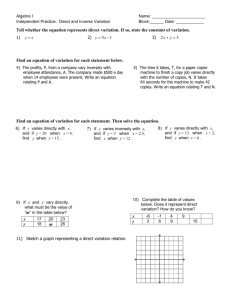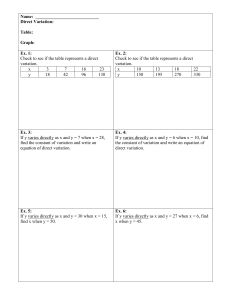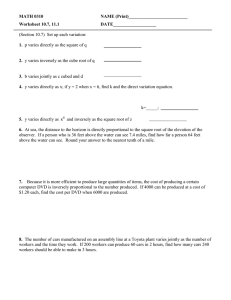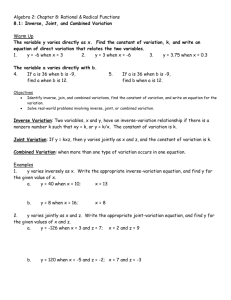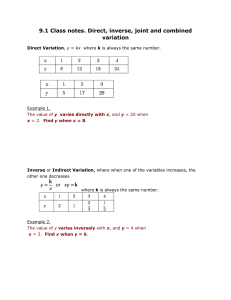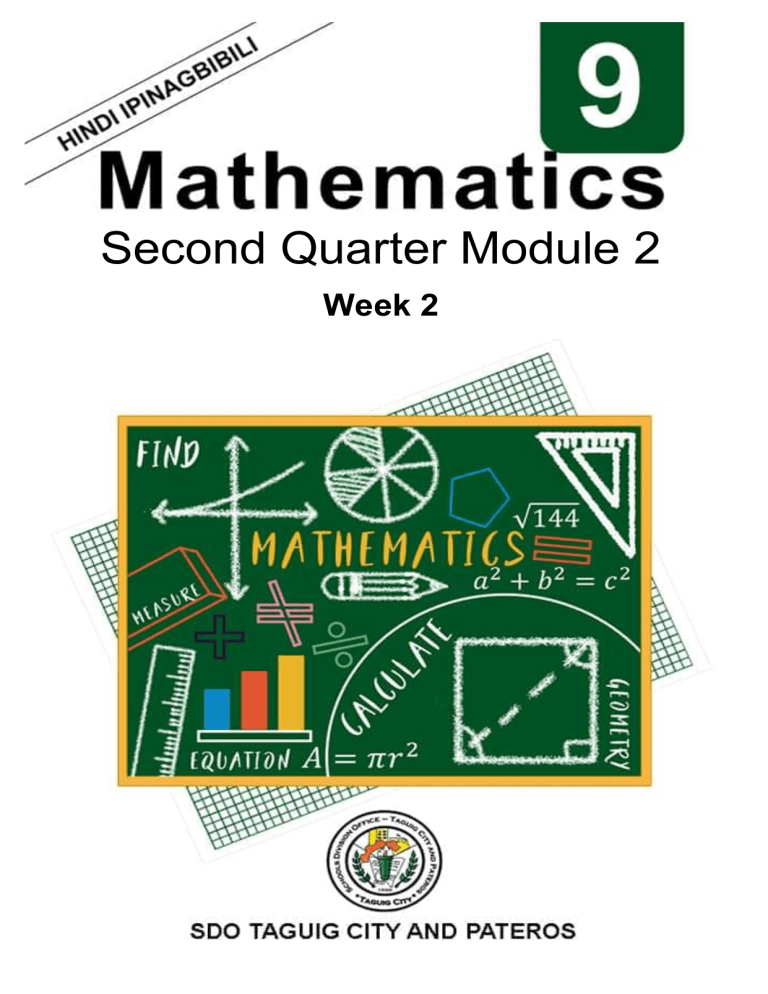
\ Second Quarter Module 2 Week 2 SDO TAGUIG CITY AND PATEROS Introductory Message For the facilitator: This module was collaboratively designed, developed and evaluated by the Development and Quality Assurance Teams of SDO TAPAT to assist you in helping the learners meet the standards set by the K to 12 Curriculum while overcoming their personal, social, and economic constraints in schooling. As a facilitator, you are expected to orient the learners on how to use this module. You also need to keep track of the learners' progress while allowing them to manage their own learning. Furthermore, you are expected to encourage and assist the learners as they do the tasks included in the module. For the learner: This module was designed to provide you with fun and meaningful opportunities for guided and independent learning at your own pace and time. You will be helped to process the contents of the learning resource while being an active learner. The following are some reminders in using this module: 1. Use the module with care. Do not put unnecessary mark/s on any part of the module. Use a separate sheet of paper in answering the exercises. 2. Don’t forget to answer Let’s Try before moving on to the other activities included in the module. 3. Read the instruction carefully before doing each task. 4. Observe honesty and integrity in doing the tasks and in checking your answers. 5. Finish the task at hand before proceeding to the next. 6. Return this module to your teacher/facilitator once you are through with it. If you encounter any difficulty in answering the tasks in this module, do not hesitate to consult your teacher or facilitator. Always bear in mind that you are not alone. We hope that through this material, you will experience meaningful learning and gain deep understanding of the relevant competencies. You can do it! Let’s Learn This module was designed and written with you in mind. It is here to help you master Variation. The scope of this module permits it to be used in many different learning situations. The language used recognizes the diverse vocabulary level of students. The lessons are arranged to follow the standard sequence of the course. But the order in which you read them can be changed to correspond with the textbook you are now using. After going through this module, you are expected to: 1. illustrate situations that involve the following variations: (a) joint and (b) combined; 2. translate into variation statement a relationship between two quantities given a mathematical equation; and 3. solve problems involving variation. Let’s Try Directions: Read each question carefully and solve if necessary. Choose the letter of the correct answer and write it before the number. 1. The statement, ℎ varies directly as 𝑖𝑖 and inversely as 𝑗𝑗 is an example of _________. A. direct variation C. joint variation B. inverse variation D. combined variation 2. Which of the following is an equation of joint variation? A. 𝑦𝑦 = 𝑥𝑥 B. 𝑦𝑦 = 8𝑥𝑥 8 C. 𝑦𝑦 = 8𝑥𝑥𝑥𝑥 D. 𝑦𝑦 = 8𝑥𝑥 2 3. Find the value of the constant of variation if 𝑚𝑚 varies jointly as 𝑝𝑝 and 𝑞𝑞, and 𝑚𝑚 = 24 when 𝑝𝑝 = 3 and 𝑞𝑞 = 4 A. 2 B. 4 C. 6 D. 8 4. If 𝑐𝑐 varies directly as 𝑝𝑝 and inversely as 𝑟𝑟. Find k when 𝑐𝑐 = 2, 𝑝𝑝 = 1 and 𝑟𝑟 = 4 A. 8 B. 4 C. 2 D. 1 5. The mass of a concrete block varies jointly as its length, width and thickness. If the mass of a 10 in by 6 in by 4 in concrete block is 120 kg, find the mass of 12 in by 5 in by 6 in concrete block. A. 120 B. 140 C. 160 D. 180 6. In the equation 𝑤𝑤 A. 𝑘𝑘 = 𝑘𝑘𝑘𝑘 𝑣𝑣 , 𝑣𝑣 ≠ 0, what varies directly as 𝑤𝑤? B. 𝑤𝑤 C. 𝑣𝑣 D. 𝑢𝑢 7. Express the statement “ 𝑄𝑄 varies directly as 𝑚𝑚 and inversely as 𝑝𝑝2 ” in equation. A. 𝑄𝑄 = 𝑚𝑚 𝑝𝑝2 B. 𝑄𝑄 = 𝑘𝑘𝑘𝑘𝑝𝑝2 C. 𝑄𝑄 = 𝑘𝑘𝑘𝑘 𝑝𝑝2 D. 𝑄𝑄 = 𝑚𝑚𝑝𝑝2 8. Suppose 𝐷𝐷 varies directly as 𝑒𝑒 and inversely as 𝑓𝑓, and 𝐷𝐷 = 10 when 𝑒𝑒 = 5 and 𝑓𝑓 = 2. What is A. 3 4 𝑒𝑒 𝑓𝑓 when 𝐷𝐷 = 3? B. 1 4 C. 1 D. 3 9. If 𝑤𝑤 varies directly as the square of 𝑥𝑥 and inversely as 𝑝𝑝 and 𝑞𝑞. If 𝑤𝑤 = 12 when 𝑥𝑥 = 4, 𝑝𝑝 = 2 and 𝑞𝑞 = 20, find 𝑤𝑤 when 𝑥𝑥 = 3, 𝑝𝑝 = 8 and 𝑞𝑞 = 5. A. 10 B. 9 C. 27 4 D. 5 10. The amount of gasoline used by a car varies jointly as the distance travelled and the square root of the speed. Suppose a car used 25 liters on a 100 km trip at 100 kph, about how many liters will it used on a 1000 km trip at 64 kph? A. 100 L B. 200 L C. 300 L https://forms.gle/zDWi33wEkwk8C1AE8 D. 400 L Lesson 2 Joint Variation and Combined Variation Let’s Recall Answer the following: 1. If 𝑎𝑎 varies directly as 𝑏𝑏, give the equation of variation? 2. If 𝑎𝑎 varies inversely as the square of 𝑏𝑏, and 𝑎𝑎 = 6 when 𝑏𝑏 = 3. Find 𝑘𝑘? 3. If 𝑎𝑎 varies directly as the square of 𝑏𝑏, what is a when 𝑘𝑘 = 4 and 𝑏𝑏 = 3? 4. If 𝑎𝑎 varies inversely as the cube of 𝑏𝑏, and 𝑎𝑎 = 5 when 𝑏𝑏 = 2, what is 𝑎𝑎 when 𝑏𝑏 = 4? 5. If 𝑎𝑎 varies directly as the square of 𝑏𝑏, and 𝑎𝑎 = 16 when 𝑏𝑏 = 8 a. find 𝑎𝑎 in terms of 𝑏𝑏. b. find 𝑏𝑏 when 𝑎𝑎 = 4. c. find 𝑎𝑎 when 𝑏𝑏 = 5. Let’s Explore Do these vehicles have the same tires? Why do you think tires vary from one vehicle to another? What do you think are the factors affecting the kind of tires used in a specific vehicle? The size of a tire and thickness of the rubber used consider the weight of the vehicle to balance and maximize its efficiency. The weight of the vehicle is said to varies jointly as the size of tires and thickness of the rubber in fabricating the wheels. Also, the terrain where the vehicle will primarily be used, among others are taken into consideration. Tire pressure also varies. The formula 𝑃𝑃 = 0.25𝑊𝑊 𝐴𝐴 gives the recommended tire pressure for each tire for the total weight (𝑊𝑊) of a vehicle and the area (𝐴𝐴) of the ground covered by tire. Notice that pressure varies directly as the weight of the vehicle and inversely as the area of the ground. The formula 𝑃𝑃 = 0.25𝑊𝑊 𝐴𝐴 is an example of combined variation. Let’s Explain, Analyze & Solve Relationship between one variable over another variable were given emphasis in the previous discussion. Relationship could be directly or inversely proportional, but sometimes one variable may vary directly /or inversely with more than one variable. One variable may vary as the product of several variables (even if it is raised to a certain exponent). The variable is said to vary jointly as the others, thus the relation is called joint variation. In the equation, 𝒚𝒚 = 𝒌𝒌𝒌𝒌𝒌𝒌, y is said to varies jointly as x and z, likewise in 𝑎𝑎 = 𝑘𝑘𝑘𝑘𝑐𝑐 2 , a varies jointly as b and the square c. In the equation 𝐲𝐲 = 𝐤𝐤𝐤𝐤 𝐳𝐳 , y is said to vary directly as x and inversely as z. Equation composed of both direct and inverse variation is called combined variation. Example 1: If y varies jointly as x and z, and 𝑦𝑦 = 6 when 𝑥𝑥 = 10 and 𝑧𝑧 = 8, find y when 𝑥𝑥 = 4 and 𝑧𝑧 = 40. Solution: The equation is Solve for k 𝑦𝑦 = 𝑘𝑘𝑘𝑘𝑘𝑘 6 = 𝑘𝑘(10)(8) 6 = 80𝑘𝑘 6 = 𝑘𝑘 80 3 𝑘𝑘 = 40 The equation is Solve for y 3 𝑥𝑥𝑥𝑥 40 3 𝑦𝑦 = (4)(40) 40 𝑦𝑦 = 12 𝑦𝑦 = To watch a video tutorial on Joint Variation by Teacher Justin (2020), visit this link https://youtu.be/w-HYWEpdsc Examples 2: The volume of a right cylinder varies jointly with the square of its radius and its height. When the radius is 2cm and the height is 6 cm, the volume is 75.36 𝑐𝑐𝑐𝑐3 . a. What is the constant of variation? b. What is the equation of variation? c. What is the volume if 𝑟𝑟 = 3 𝑐𝑐𝑐𝑐 and ℎ = 5 𝑐𝑐𝑐𝑐? Solutions: 𝑉𝑉 = 𝑘𝑘𝑟𝑟 2 ℎ 75.36 = 𝑘𝑘(2)2 (6) 75.36 = 𝑘𝑘 24 Volume varies jointly with the square of the radius and height 3.14 = 𝑘𝑘 𝑉𝑉 = 3.14𝑟𝑟 2 ℎ 𝑉𝑉 = 3.14(3)2 (5) 𝑉𝑉 = 3.14(45) 𝑉𝑉 = 141.3𝑐𝑐𝑐𝑐3 This is the constant of variation This is the equation of variation. If 𝑦𝑦 = 3 𝑐𝑐𝑐𝑐 and ℎ = 5 𝑐𝑐𝑐𝑐, then the volume is 141.3𝑐𝑐𝑐𝑐3 To watch a video tutorial on Joint Variation and Word Problems by Highschoolreviewer (2019), visit this link https://youtu.be/ZdEudOOuU6I Example 3: If y varies directly as x and inversely as z. If 𝑦𝑦 = 4 when 𝑥𝑥 = 6 and 𝑧𝑧 = 3, find y when 𝑥𝑥 = 15 and 𝑧𝑧 = 10. Solutions: 𝑘𝑘𝑘𝑘 𝑧𝑧 𝑘𝑘(6) 4= 3 𝑦𝑦 = 12 = 6𝑘𝑘 2 = 𝑘𝑘 2𝑥𝑥 𝑧𝑧 2(15) 𝑦𝑦 = 10 𝑦𝑦 = 3 𝑦𝑦 = Replace y with 4, x with 6, and z with 3 Cross multiply This is the constant of variation This is the equation of variation. To watch a video tutorial on Combined Variation by Teacher Justin(2020), visit this link https://youtu.be/QNpTNPO00A0 Let’s Dig In Activity 1. Write the equation for each of the following statements. 1. N varies directly as P and inversely as Q. 2. Y varies jointly as R and T. 3. B is directly proportional to the square of A and inversely proportional to the cube of C. 4. The area (A) of a triangle varies jointly as the base (b) and the height (h). 5. The time (t) required to dig a ditch of fixed width and depth varies directly as the length (l) of the ditch and inversely as the number of man (m) working on the job. 6. The volume (V) of a circular cone varies jointly as its height (h) and the square of the radius (r) of its base. 7. The pitch (P) of a stretched vibrating string varies directly as the square of the tension (T) and inversely as the length (l) of the string. 8. The pressure (P) of a gas varies jointly as its density (d) and its absolute temperature (t). 9. The volume (V) of right circular cylinder varies jointly as its height (h) and the square of the radius (r) of its circular base. 10. The current (I) varies directly as the electromotive force (F) and inversely as the resistance (R). Activity 2. Find the equation then solve for the missing value. 1. 𝑝𝑝 varies directly as q and t, and 𝑝𝑝 = 60 when 𝑞𝑞 = 24 and 𝑡𝑡 = 5. Find 𝑝𝑝 when 𝑞𝑞 = 12 and 𝑡𝑡 = 4. 2. 𝑣𝑣 varies directly as 𝑤𝑤 and 𝑢𝑢, and 𝑣𝑣 = 28 when 𝑤𝑤 = 8 and 𝑢𝑢 = 7. Find 𝑣𝑣 when 𝑤𝑤 = 14 and 𝑢𝑢 = 9. 3. Suppose 𝑦𝑦 varies jointly as the square of 𝑥𝑥 and 𝑧𝑧, and 𝑦𝑦 = 21 when 𝑥𝑥 = 3 and 𝑧𝑧 = 2 7. Find y when 𝑥𝑥 = 6 and 𝑧𝑧 = 3. 4. Suppose 𝑦𝑦 varies jointly as 𝑥𝑥 and the square of 𝑧𝑧, and 𝑦𝑦 = 4 when 𝑥𝑥 = 50 and 𝑧𝑧 = 2 . 5 Find y when 𝑥𝑥 = 1 and 4 𝑧𝑧 = 4. 5. 𝑦𝑦 varies directly as 𝑥𝑥 and inversely as z, and 𝑦𝑦 = 6 when 𝑥𝑥 = 8 and 𝑧𝑧 = 4. Find y when 𝑥𝑥 = 12 and 𝑧𝑧 = 9. 6. 𝑎𝑎 varies directly as 𝑏𝑏 and 𝑐𝑐, and 𝑎𝑎 = 90 when 𝑏𝑏 = 6 and 𝑐𝑐 = 3. Find 𝑎𝑎 when 𝑏𝑏 = 1 4and 𝑐𝑐 = 2. 7. 𝑎𝑎 varies directly as 𝑏𝑏 and inversely as 𝑐𝑐, and 𝑎𝑎 = 5 when 𝑏𝑏 = 2 and 𝑐𝑐 = 4. Find a when 𝑏𝑏 = 5 and 𝑐𝑐 = 25. 8. 𝑚𝑚 varies directly as 𝑛𝑛 and inversely as 𝑝𝑝, and 𝑚𝑚 = 8 when 𝑛𝑛 = 1 and 𝑝𝑝 = 1. Find 𝑚𝑚 3 4 when 𝑛𝑛 = and 𝑝𝑝 = 3. 2 4 9. 𝑝𝑝 varies directly as 𝑞𝑞 and inversely as 𝑟𝑟, and 𝑝𝑝 = 6 when 𝑞𝑞 = 12 and 𝑟𝑟 = 0.5. Find 1 p when 𝑞𝑞 = 8 and 𝑟𝑟 = 3. 10. 𝑚𝑚 varies directly as 𝑛𝑛 and inversely as 𝑝𝑝 and 𝑚𝑚 = 5 when 𝑛𝑛 = 3 and 𝑝𝑝 = 1. Find m 4 5 when 𝑛𝑛 = 9 and 𝑝𝑝 = 6. Let’s Remember • In joint variation, one variable may vary directly or indirectly with more than one variable or the first variable is said to vary jointly as the others, if one variable varies as the product of several other variables (even if the variable is raised to a certain exponent). • Combined variation shows combination of direct and inverse variation. • In the equation, 𝒚𝒚 = 𝒌𝒌𝒌𝒌𝒌𝒌, y is said to varies jointly as x and z, likewise in 𝑎𝑎 = 𝑘𝑘𝑘𝑘𝑐𝑐 2 , a varies jointly as b and the square c. • In the equation 𝐲𝐲 = , y is said to vary directly as x and inversely as z. Equation 𝐳𝐳 composed of both direct and inverse variation is called combined variation. 𝐤𝐤𝐤𝐤 Let’s Apply Solve the following problems: 1. The weight of the rectangular block (𝑊𝑊)of metal varies jointly as the length (𝑙𝑙), the width (𝑤𝑤), and the thickness (ℎ). If the weight of a 12 cm by 8 cm by 6 cm block of metal is 18 kg, find the weight of a 16 cm by 10 cm by 4 cm block of metal. 2. The wind force (𝐹𝐹) on a flat surface varies jointly as the area of the surface (𝐴𝐴) and the square of the wind velocity (𝑣𝑣). If the pressure on 1𝑓𝑓𝑓𝑓 2 is 2 lbs, when the wind velocity is 20mi/hr, find the force of the wind storm on 10 ft by 12 ft signboard that has a velocity of 60 mi/hr. 3. The area of a rhombus (𝐴𝐴) varies jointly as the length of the two diagonals (𝑑𝑑1 and 𝑑𝑑2 ). If a rhombus whose diagonals are 10 cm and 8 cm long has an area of 40 𝑐𝑐𝑐𝑐2 , find the area of the rhombus whose diagonals are 11 cm and 15 cm. 4. A simple interest (𝐼𝐼) varies jointly with the amount of principal (𝑃𝑃) and the length of time (𝑡𝑡). Suppose 𝐼𝐼 = 𝑃𝑃ℎ𝑝𝑝 600 when 𝑃𝑃 = 𝑃𝑃ℎ𝑝𝑝 10 000 and 𝑡𝑡 = 2 𝑦𝑦𝑦𝑦𝑦𝑦, how much should be deposited to get an interest of ₱ 1 200 in a year? 5. If five carpenters can finish 30 tables in 2 days, how long will it take for 8 carpenters to finish 100 tables? Let’s Evaluate Directions: Read each question carefully and solve if necessary. Choose the letter of the correct answer and write it before the number. 1. If 𝑟𝑟 varies directly as 𝑠𝑠 and inversely as 𝑡𝑡. Find 𝑘𝑘 when 𝑟𝑟 = 40, 𝑠𝑠 = 5 and 𝑡𝑡 = 6 A. 48 B. 40 C. 30 D. 8 2. The weight of a rectangular block of wood varies jointly as its length, width and thickness. If the weight of a 13 dm by 8 dm by 6 dm. block of wood is 26 kg, find the weight of 12 dm by 8 dm by 3 dm block of wood. A. 10 kg B. 12 kg C. 14 kg D. 16 kg 3. Translate to a mathematical sentence, if k is the constant of variation, “the volume 𝑉𝑉 of a pyramid varies jointly as the area of the base 𝐵𝐵 and altitude ℎ”. A. 𝑉𝑉 = 𝑘𝑘𝐵𝐵2 ℎ B. 𝑉𝑉 = 𝑘𝑘𝑘𝑘ℎ C. 𝑉𝑉 = 𝑘𝑘𝑘𝑘 ℎ D. 𝑉𝑉 4. Find the value of the constant of variation if 𝑦𝑦 varies jointly as 𝑏𝑏 and 𝑐𝑐, and 𝑦𝑦 = 256 when 𝑏𝑏 = 8 and 𝑐𝑐 = 4. A. 2 B. 4 C. 6 D. 8 5. In the equation 𝑧𝑧 = 𝑘𝑘𝑘𝑘𝑘𝑘 𝑦𝑦 , 𝑦𝑦 ≠ 0, what varies inversely as 𝑧𝑧? a. 𝑘𝑘 b. 𝑥𝑥 c. 𝑛𝑛 6. Express the statement “ 𝑊𝑊 varies directly as 𝑥𝑥 3 and inversely as 𝑦𝑦 2 ”. a. 𝑊𝑊 = 𝑥𝑥 3 𝑦𝑦 2 b. 𝑊𝑊 = 𝑘𝑘𝑥𝑥 3 𝑦𝑦 2 c. 𝑊𝑊 = 𝑘𝑘𝑥𝑥 3 𝑦𝑦 2 = 𝑘𝑘𝐵𝐵2 ℎ d. 𝑦𝑦 d. 𝑊𝑊 = 𝑥𝑥 3 𝑦𝑦 2 7. Suppose 𝑧𝑧 varies directly as 𝑦𝑦 and inversely as 𝑥𝑥, and 𝑧𝑧 = 12 when 𝑥𝑥 = 8 and 𝑦𝑦 = 24. What is a. 1 2 𝑥𝑥 𝑦𝑦 when 𝑧𝑧 = 16? b. 1 c. 2 4 d. 4 8. The statement, 𝑤𝑤 varies jointly as 𝑐𝑐 and the square of 𝑎𝑎 and inversely as 𝑏𝑏 is an example of a. direct variation c. joint variation b. inverse variation d. combined variation 9. Which of the following is an equation of combined variation? A. 𝑦𝑦 = 8𝑥𝑥 𝑧𝑧 B. 𝑦𝑦 = 8 𝑥𝑥 C. 𝑦𝑦 = 8𝑥𝑥𝑥𝑥 D. 𝑦𝑦 = 8𝑥𝑥 2 10. The current I varies directly as the electromotive force E and inversely as the resistance R. If a current of 30 ampere flows through a system with 16 ohms resistance and the electromotive force of 120 volts. Find the current that a 200 volt-electromotive force with the same resistance will send through the system. 8 A. 100 A B. 50 A C. 18 A D. A 25 https://forms.gle/BCvjHHf2vgy6BegZA References Nivera, Gladys C., et. al., GRADE 9 MATHEMATICS (Patterns and Practicalities), Salesiana Books, 2013 Orines, Fernando B., et. al., NEXT CENTURY MATHEMATICS (Intermediate Algebra), Phoenix Publishing House, 2003 Oronce, Orlando A., et. al., E-MATH 9 (Work text in Mathematics), Rex Book Store, 2015 Tesorio, Ma. Luisa V., MATHEMATICS 2 ( An Alternative Learning System – The Modular Approach) 2018 Edition, Tru-Copy Publishing House Inc., 2008 Yeo, Joseph, et. al, NEW SYLLABUS MATHEMATICS 9, Rex Book Store, 2017 MATHEMATICS GRADE 9, LEARNER’S MATERIAL, Department of Education, First Edition, 2014 Kahaarlytskyi, M., 2016. Toy car [image] Available at: < https:// https://unsplash.com/photos/ lDkAGfmHdeI> [Accessed 2 January 2021] Development Team of the Module Writer: JOSEPH C. LAGASCA Editors: Content Evaluators: JOEY N. ABERGOS AMELIA A. CANZANA ALMA J. CAPUS JENNIFER N. CONSTANTINO MARIO D. DE LA CRUZ JR. NAUMI G. LIGUTAN DONALYN S. MIÑA JULIUS PESPES Language Evaluator: MARICAR RAQUIZA Reviewers: DR. LELINDA H. DE VERA MIRASOL I. RONGAVILLA JENNICA ALEXIS B. SABADO DR. MELEDA POLITA Management Team: DR. MARGARITO B. MATERUM, SDS DR. GEORGE P. TIZON, SGOD-Chief DR. ELLERY G. QUINTIA, CID-Chief MRS. MIRASOL I. RONGAVILLA, EPS-Mathematics DR. DAISY L. MATAAC, EPS-LRMS / ALS For inquiries, please write or call: Schools Division of Taguig city and Pateros Upper Bicutan Taguig City Telefax: 8384251 Email Address: sdo.tapat@deped.gov.ph
